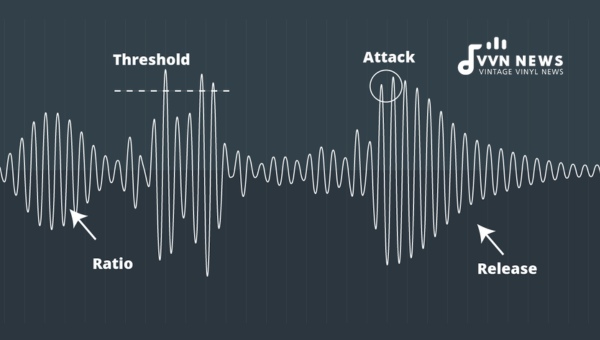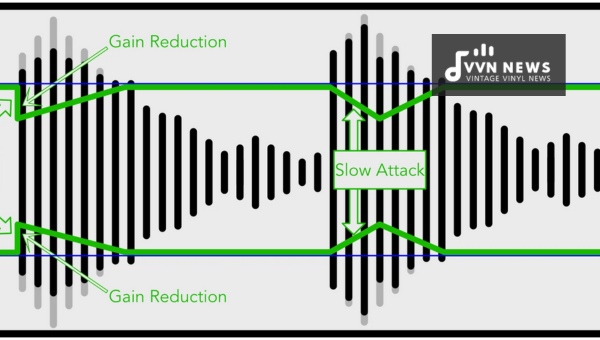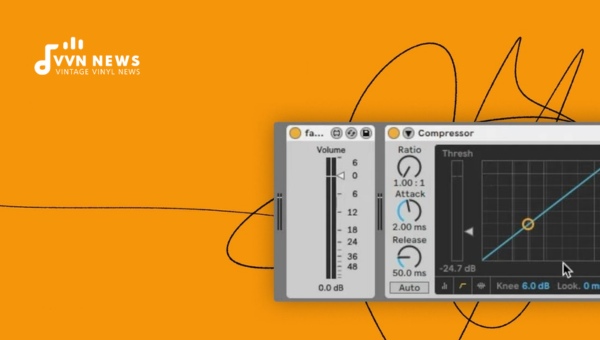If you’re an audiophile like me or just inherently curious about the inner workings of your sound system, you’ve probably asked yourself, how do analog stereo compressors work?
While it may seem complex on the surface, delving into the mechanics of this vital device can become a fascinating musical journey.
In our day-to-day lives, we encounter a variety of sounds – from the hushed whispers of an early morning to the boisterous din of a city in full throttle.
But have we ever paused to ponder how these auditory experiences reach us in smooth and balanced waves while listening to music on our stereo systems?
The answer lies in a small yet significant analog stereo compressor that seamlessly regulates sound levels for optimal audio quality.
On that note, let’s unravel the inner workings of this incredible device and understand precisely how it shapes our musical perceptions.
What is an Analog Stereo Compressor?
An analog stereo compressor is an integral component within an audio system that processes and balances audio signals.
The primary purpose of this device is to control the dynamic range, which is essentially the difference between the loudest and softest parts of a sound.
Compressors target peaks in the music’s waveforms, reducing them when they cross a certain level.
This process helps maintain a consistent audio signal level, ensuring that every sound’s essence can be perceived without distortion or abrupt shifts in volume.
The analog aspect refers to the way these devices handle input signals. Unlike their digital counterparts, analog stereo compressors continuously process physical signals—often voltages or currents.
This leads to subtle variations in how the compressed sound eventually rolls out, adding what some enthusiasts term ‘warmth’ to the output.
In musical terms, the role of an analog stereo compressor can be likened to a meticulous editor who tweaks and polishes each word (or note) so that it fits smoothly into your overall listening experience.
How Do Analog Stereo Compressors Work?

An analog stereo compressor works by detecting volume levels in the audio signal that exceed a threshold and then reducing them to create a more consistent and balanced sound. Let’s break down the process.
Detection Circuit
The heart of the compressor is the detection circuit. It monitors the level of your audio signal, constantly checking if it exceeds the established threshold.
Voltage-Controlled Amplifier (VCA)
When volume levels spike above this threshold, the detection circuit kicks into action, sending a signal for reduction to the Voltage-Controlled Amplifier (VCA).
This device compresses, reducing the gain on louder parts of your music or any input sounds based on inputs from the detection circuit.
Control Circuit
The VCA’s actions are guided via a Control Circuit. This crucial part sets specific parameters—like attack time (how quickly compression begins), release time (when it ends), ratio (the degree of sound reduction), and knee (the abruptness or smoothness of onset).
Manipulating these parameters shapes how audible the results are.
Sound Path In Action
The audio signal enters an analog stereo compressor at an input stage, split into two paths – one path heads straight to the output stage without modifications. In contrast, the other goes towards the detection circuit.
Once a peak is detected in the second path crossing the predetermined threshold – the control circuit instructs VCA in the first path to scale down amplification, thereby compressing louder sound parts.
The goal here is not necessarily to make anything quieter but to tame too loud sounds so that more modest elements can be heard more clearly without turning up the entire volume level.
Discussing context of music production – once peaks are restrained by compression, producers can increase overall track volume without causing distortion or clipping for improved mix balance.
But, when signals flow through an analog stereo compressor, some potential spikes get smoothed down, and variations are ironed out, leaving more balanced, polished audio that lies perfectly within the dynamic range. It’s quite like a meticulous craftsman shaping a musical sculpture for your ears!
Also Read: What Is A Studio Compressor? [Do You Need It For Home Studio?]
The Inner Workings of Analog Stereo Compressors
The underlying principle of an analog stereo compressor revolves around the concept of dynamic range, the distance between the softest and loudest sounds.
To delve deeper into how exactly this device functions, let’s decode its key components.
Critical Components of an Analog Stereo Compressor
- Voltage-Controlled Amplifier (VCA): This entity is the actual engine that manipulates the signal’s volume. It dynamically adjusts its gain (amplification factor) based on the control voltage it receives.
- Detection Circuit: Also known as a level detection circuit, it monitors incoming signals to decide when the compressor should activate itself. It discerns if an audio signal has exceeded the predetermined threshold, a crucial parameter in compression.
- Control Circuit: This element governs how much gain reduction should occur once a signal crosses the set threshold. The control circuit works with other parameters like attack and release time to shape the output sound.
Bridge between Circuits
The symbiotic relationship between these components forms the bedrock of a compressor’s functionality. When an audio signal exceeds the threshold, it bolsters the control circuit to send a voltage command to VCA.
Subsequently, VCA reduces its gain, leading to a softer output volume.
This feedback loop is deactivated once reduced to below-threshold levels until another spike occurs.
The Signal Flow in Analog Stereo Compressors
Feeling confused about what happens after you have your desired settings dialed in? Fear not! Let’s break down how your sound signals move within a compressor:
- The audio signal enters via an input device such as a microphone or digital interface.
- Upon reaching thresholds, detection circuits notify control circuits that swing into action.
- Control circuits feed instructions to VCAs for requisite adjustments.
- Post VCA modulation, sound emanates with a regulated dynamic range, ready for your listeners to relish.
Analog stereo compressors intricately balance the audio spectrum through their internal constituents, making every note, every sound, and beat fall into place — a harmony that makes your music resonate.
Components of an Analog Stereo Compressor

Every analog stereo compressor comprises three essential parts: a Voltage-Controlled Amplifier (VCA), a Detection Circuit, and a Control Circuit.
Voltage-Controlled Amplifier (VCA)
The VCA serves as the action center of the compressor. It modifies the audio signal’s amplitude, or volume, in response to a control voltage it receives.
When the control voltage rises, the amplitude reduces – effectively compressing the signal. As such, you can think of the VCA as ‘where the magic happens’ because this is where actual compression is implemented.
Detection Circuit
The Detection Circuit operates similarly to a vigilant watchman – constantly monitoring your audio signal.
It measures how loud it is at any given moment and channels that information back to other components as what’s known as a ‘level detection signal.’
Fundamentally, this circuit gauges when the incoming amplitude exceeds your defined threshold, thus deciding when compression should be applied.
Control Circuit
The Control Circuit is an intermediary between your detection circuit and your VCA.
On receiving information from your detection circuit that signals are breaching set thresholds, it generates and sends a command in terms of control voltage to your VCA.
Thus signaling that it’s time to lower those high amplitudes.
You can think of these three components working together like a finely coordinated orchestra: one instrument raises too loud, another takes note and signals a third one, which then adjusts its tone accordingly to restore balance.
These key components underscore how intuitive and reactive an analog stereo compressor is in maintaining volume balance.
Also Read: How To Compress Vocals For Pro Results 2025 [Mistakes To Avoid]
Compression Parameters and Controls Explained
Getting the most out of an analog stereo compressor involves understanding the control knobs and parameters.
Let’s take an in-depth look into what constitutes these parameters:
Threshold
This is the level at which compression begins, often measured in decibels (dB). Any part of the audio that exceeds this level will be compressed upon setting a threshold.
Music with a dynamic range that exceeds this set threshold will face more compression, resulting in a smoother, even volume across the track.
Ratio
The ratio is the amount of gain reduction that happens when your signal passes the threshold.
It’s described as input to output, so a 4:1 ratio means if your input level increases by 4 dB past the point, your work only increases by 1 dB.
For instance, you have a high ratio approaching infinity:1 (also known as ‘limiting’).
This would make anything over the threshold come out at one constant volume!
Attack and Release Time
Have you ever wondered where nuances come into play? That’s where Attack and Release time step into the spotlight!
Attack time relates to how swiftly your compressor responds once your signal surpasses the set threshold.
Speed is usually gauged in milliseconds – shorter times for faster responses and longer for slower reactions.
Quick attack time tames transients efficiently but may dull percussive sounds. Conversely, longer attack times allow more transients while preserving some natural dynamics.
Conversely, Release time refers to how quickly or slowly your compressor stops compressing after the volume drops below your defined threshold.
Short release times return dynamics quickly but might make compression more noticeable; lengthy ones can bring about more consistent sound levels.
Makeup Gain
After carrying out all these processes, you might have quieter audio than before.
This is where the Makeup Gain comes in – to restore lost levels. It’s a control that allows you to increase the output level of your signal after compression, hence ‘making up’ for volume reduced by reduction.
Compressors’ magic lies in their ability to iron out dynamic kinks and shape usable and creative tones.
Knowing how they work puts you in control of your audio experiences, whether listening, performing, or recording.
While this knowledge doesn’t replace hands-on experience, understanding these parameters and practicing with authentic sounds can enrich and augment your musical ventures.
Also Read: Multiband Compression And EQ 2025 [How And When To Use?]
Sidechain Compression in Analog Stereo Compressors

A key concept of analog stereo compressors is sidechain or sidechain compression.
To decode these terms, let’s first look at what a sidechain is. It refers to a separate input pathway in the compressor that ‘listens’ to the audio signal independently of the main signal-the one that’s getting compressed.
Sidechain Compression, also known as Ducking, works by reducing the volume of one sound based on the level of another sound.
This process is extensively used in radio broadcasts, where music volume dips whenever the presenter speaks, ensuring every word comes across loud and clear without competing with the background score.
How does it work?
- The music track (main track) and vocal track (side chain) are fed into the compressor.
- The compressor’s detection circuit monitors the side chain (vocal) instead of the main track (music).
- Whenever vocals come in, if they cross a predetermined volume level (Threshold), it prompts compression on the main track.
- Post compression, audio levels dip on your primary signal, allowing vocals to shine through clearly.
Sidechain compression helps enhance clarity and maintain a balance between various sound elements—key aspects when aiming for high-quality audio output.
Applications of Analog Stereo Compressors in Sound Recording and Mixing
Analog stereo compressors are critical in ensuring the audio signals are balanced and consistent, which is especially important in sound recording and mixing.
Below, we delve into some of the typical applications of these devices within these processes:
Ensuring Consistent Levels
Keeping volume levels consistent is one of the foremost tasks when recording audio, especially vocals.
Singers may naturally fluctuate between lower and higher volumes in their performance.
An analog stereo compressor helps manage these variations by lowering high volumes and amplifying softer sounds, ensuring a more consistent track.
Enhancing Transients
Transient is a term that describes the initial burst of energy in a sound wave. This would be the immediate sound in a drum beat or a plucked guitar string.
Compressors give you control over these transients with attack and release parameters, enabling you to make certain elements punchier or smoother.
Providing Textural Quality
Compressors are also tools for generating unique textures in music production. By altering different parameters, producers can lend specific characteristics to sounds, contributing to textural qualities such as thickness or brightness.
This applies to electronic music genres where beats and synths are foundational elements.
Balancing Mix Elements
An analog compressor is crucial when mixing down tracks. Reducing dynamic range ensures that no element of your mix dominates over others due to loudness disparities.
For instance, if your vocals are drowning out the guitar riffs in certain sections due to higher peak volumes, compression can mitigate this issue effectively, ensuring every element sits together succinctly.
Creating Space with Sidechain Compression
Sidechain compression allows one track—say drums—to trigger contractions on another, like bass or synths.
The resulting “pumping” effect creates rhythmic space for each instrument track so they have their moment in the spotlight without clashing with each other. It’s a staple technique in many genres like house, EDM, and hip-hop.
Analog stereo compressors offer an array of possibilities for shaping sound in music production.
Whether balancing out volume levels during recording or adding certain textural qualities to your mix, understanding how to utilize a compressor can significantly enhance your audio creation process.
Also Read: What Is Audio Clipping? [Digital Clipping Vs Analog Clipping]
Analog Stereo Compressor Models

In the sphere of audio equipment, there are many models with various features and capabilities.
Some models stand out among the crowd due to their superior quality and exemplary performance.
Let’s look at these extraordinary models in the world of analog stereo compressors.
SSL Bus+ Next-Generation Stereo Bus Compressor
The SSL Bus + is a hallmark in analog stereo compressor technology. Developed by Solid State Logic, this state-of-the-art unit is unparalleled in dynamic range control.
Unique features such as its intuitive user interface and side-chain input make it remarkably user-friendly.
The model boasts a high-quality stereo compressor with three selectable ratios (2:1, 4:1, 10:1).
The auto-release allows for easier handling of complex inputs. At the same time, the ‘SC High Pass’ adds further flexibility in operation.
This model carries forward the legendary SSL G series audio lineage and refines it for modern production environments.
If you seek precision and versatility packed into one solid unit, this model deserves your consideration.
SSL G-Comp 500 Series Stereo Bus Compressor Module
The SSL G-Comp is another marvel from Solid State Logic that continues to be favored by music professionals worldwide.
This module replicates the sonic characteristics of its big brother, the SSL above Bus+.
This unit is particularly admired for its punchy quality, making it an excellent choice for pop mixes or any genre seeking a rhythmic solid impact.
The addition of ‘auto fade’ duration settings makes it even more versatile in achieving slick transition effects within your mix.
Universal Audio LA-2A Electro-Optical Classic Compressor
With a revered history dating back to 1965, the Universal Audio LA-2A exhibits an enviable reputation for effortlessly achieving smooth and natural compression results.
Its exceptional T4 opto-attenuator-based compression scheme is recognized for producing outstanding musical dynamics control.
The hallmark of this model is its distinctive electro-optical detector, which allows for a superbly gentle compression response, ideal for vocals and softer instruments.
Tube-Tech CL 1B Optical Tube Compressor
Finally, let’s not forget the Tube-Tech CL 1B, a versatile and preeminently trusted optical tube compressor used throughout the professional audio industry.
Favored by producers and musicians alike, this model embodies warmth from its design, including a fully-fledged tube signal path.
The salient feature of this model is its ‘easy-glide’ feature that enables seamless transitions between different compressions without audible nudging.
In addition, its fully adjustable attack and release, ranging over three orders of magnitude, add to its flexibility in operation.
Each model offers unique sonic characteristics suitable for various music genres and recording applications.
When selecting your model, consider your needs, recording environment, budget constraints, and, most importantly, your sonic preference. After all—music, at its core, is clad in subjectivity.
FAQs About stereo compressor
What is the critical role of an analog stereo compressor in audio production?
Analog stereo compressors balance audio signals and control the dynamic range, preventing distortion and abrupt volume changes.
How does an analog stereo compressor differ from a digital one?
Unlike digital compressors that process binary signals, analog stereo compressors handle continual physical calls like voltages or currents.
What does ‘threshold’ refer to in the context of compression parameters?
In compression parameters, the ‘threshold’ denotes the level above which a sound’s amplitude will be reduced.
What do audio experts mean by ‘the warmth’ of an analog stereo compressor?
The term ‘warmth’, often associated with analog stereo compressors, refers to the unique and subtly varied output produced by processing continuous physical signals.
Can I use an analog stereo compressor in my home studio setup?
Yes, you can use an analog stereo compressor in your home studio system to maintain consistent sound quality and prevent distortions or sudden changes in volume.
Conclusion
Comprehending how an analog stereo compressor is more than just a deep dive into audio technology—it broadens our appreciation for sound in all its diversity.
By controlling dynamic range, these devices ensure that our music experience feels balanced and smooth.
Analog stereo compressors are vital elements in the audio signal chain, creating nuance and character in the music we enjoy every day.
Their function might be technical, but the outcome can vary greatly, providing unique interpretations of sound and adding color and depth to our musical experiences.








